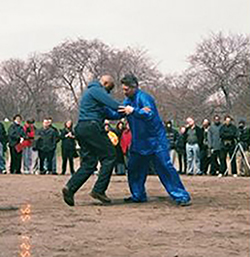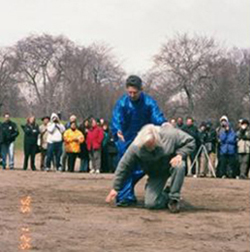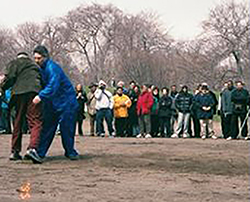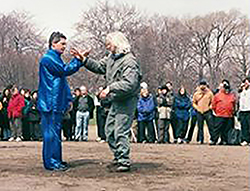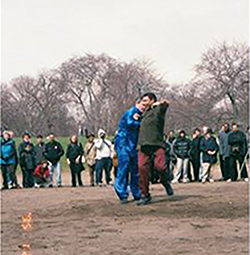
Sensitivity Training
Taijiquan's distinctive quality emerges from the ability to listen by feel. Push Hands is a method for learning this skill.
The Prelude to Self-Defense
Taijiquan is more than a solo exercise. Taijiquan is one of the internal Chinese martial arts. It trains a sophisticated set of physical, mental, and energetic skills that to be used for self-defense. It is distinguished from the external martial arts, which rely on speed, strength and techniques to overcome an assailant. A musical analogy can be made between the internal arts having the improvisational nature of jazz based on scales and charts versus the external arts having the structure and specificity of classical music.
To cultivate Taijiquan skills an emphasis is placed on sensitivity. Working with a partner is an important step. Push Hands brings the universal Taiji principles into relationship. Push Hands points out the errors in the Form. The Form is where corrections can be made. Learning to use sensitivity rather than resistance during a physical altercation involves cooperative training with trusted partners in which winning is not the objective. Working with a partner is an important step. To this end, the primary partnership practice is called "Push Hands." Push Hands brings the universal Taiji principles into relationship. Push Hands points out the errors in the Form. The Form is where corrections can be made.
Push Hands is sometimes known as "Sensing Hands," which sounds less aggressive. By either name, it is best done with an attitude of playing with your partner. You can think of push hands as a conversation. Initiated by an agreement for each player to attempt to control the center by vying to push the other away.
Gaining Control and Taijiquan Skills
The operative concept of Taijiquan is to have and maintain control first of yourself, and then to seize and maintain control of your partner/opponent. Taijiquan is a close-fighting system. Push Hands trains the ability to defend yourself when you are physically connected to your opponent. For this reason, Push Hands is the bridge between the solo practice and fighting.
Taijiquan skills are largely counter-intuitive. The typical human reaction to an incoming force is to resist it. In Taijiquan, you learn to receive and redirect it in the most efficient manner possible. The skills are based on the shapes: circle, spiral, and sphere. The power in a circle aligns with the radius. When a force encounters a circle, if it is directed from the radius, the power transits on a line from the center. When that line links to the radius of your partner, you will be able to push out on an efficient line. If you want to counter an incoming linear force, you need to turn slightly (45 degrees or less) so that the line now runs tangentially to the power defusing the linear power.
Facing Competition
There's a natural inclination to be competitive when pushing hands. Anytime you're facing off you operate with an intention to push your partner. As you work with a partner, you can rely on the fact that the original intention remains continuously in place as you explore how to control one another's center. There is no reason to concentrate on the intention. Rather you can trust that the intention is present throughout the engagement. When training with a partner, take out the desire to win and focus instead on your ability to stick, listen, and follow your opponent.
The further your skills grow the less and less you need to rely upon raw strength and speed to overcome an incoming force. In the early and mid-stages of learning the adage is to "invest in loss." When working with a partner of superior skills, avoid resisting and attempting to win. Instead feel what is happening in both you and them. Learn to identify the directions, vectors, and sources of their power. Pay attention to your own body to where muscular resistance activates and find ways to release the tension. When working with a partner, of equal or lesser skills, you can explore putting yourself in more and more vulnerable positions.
The Ability to Rotate
If a wheel can turn, then there is only one point from which you can push against it that will not cause it to turn. If the wheel is locked in position such as if the brakes are on or if instead of one axle there are two axles, when you push against the wheel it will be unable to turn.
The Taiji principle is to have a singular, pure center around which rotation is possible. Only by abiding by this principle will the ability to rotate in the Taijiquan manner be possible. In a relationship between two equally capable people where one can rotate and the other cannot, the one who can turn on an axis will overcome the fixed linear power.
Rotating requires holding the center fast. There can be no retreat and not encroachment at the point of rotation. Taiji is sometimes called "The Grand Pivot." The pivot point is still. In the case of a body, other parts of the body can move in so long as the point where the pivot takes place does not move toward or away. Because the body is complex, there can be very localized pivoting with the center at the point of contact. If the rotation is like a flywheel moving outward or a whirlpool drawing inward, the center of rotation can be elsewhere.
The Primary Importance of Maintaining Central Equilibrium
Focus on is the idea of purifying the center. This is made difficult by the fact that human beings stand on two legs. It is normal to be "double-weighted," but double-weightedness is a critical error in Taijiquan. Under the additional stress of being pushed, the inability to maintain a single center is a normal, untrained response. Taijiquan training helps develop the ability to maintain a center enabling you to rotate around an incoming push.
Double-weightedness is also to most common way an untrained person issues a push. Pushing a person as opposed to pushing an inanimate object such as a stalled car, pushing a living person is dynamic and complex task. The human body has over 200 moving joints. In push hands, the sensitivity is critical. For it is only after you feel your opponent's locking one or more joints that you issue a push.
Where so many people go wrong in their push hands practice is in the application of force. Even slight force when issued without maintaining a solitary center creates a problem. With many players, the problem is disguised by their ability to use enough power to override their error and obtain the result of a push. This is especially true when learning the skill of maintaining center. Once a person pushes with any sort of muscular tension, a link is created between the center of balance and the source of the tension. The predominant placement of this tension in experienced Taiji practitioners is in the hips. Sometimes called bracing, even when a player has a sophisticated ability to move quickly and deflect another's power, the true nature of the problem continues. If uncorrected, the player creates a ceiling on their abilities that does not rise to the level possible in correct practice.
Relaxation, Release, and Awareness
In order to experience this, participants must remain less concerned with winning than in discovering the nature of relaxed power. This is a key component to learning this skill. In order to develop the sensitivity to this unique skill, it is essential to remove power from your practice. Tension prevents you from uncovering the intrinsic power that comes from your innate structure. Your bones are extremely strong. So long as they maintain their alignment, they are many times more powerful than your muscles. When correctly performed, your structure can withstand tremendous forces. The challenge is to maintain your structure while moving and under the duress of another person's pressure. To develop the skill, work with a partner who will push you to the limits of your ability, and not beyond them. If you can practice your skills within the range of your abilities they can grow much more quickly than if you try to do so against a force stronger than you can handle.
